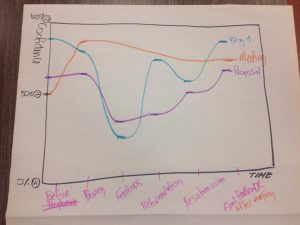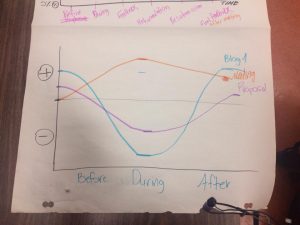Welcome back!
Here is an update of what we have been up to for the past few weeks:
February 27, 2017
This week was relatively calm, as our group was cohesive and on top of things. We finished blog post 2 and graphed our past, present, and future progress in the course during our tutorial session. This allowed us to gain a greater understanding of how all of us were feeling and helped increase group unity.
This week’s objective was to coordinate our schedules with the distribution times of the RFB and get permission to conduct interviews of the RFBs’ clients the following week.
March 6, 2017
As we were fast approaching our work in the community, our group double checked that every member had completed the TCPS tutorial on research ethics.
Next, our group decided to conduct interviews Wednesday and Saturday of this week, (March 8 and 10) respectively. We are still waiting on approval from the RFB though, so we will not proceed until and unless those times are confirmed.
Meanwhile, our objectives for this week are:
1. Complete and submit blog post 3.
2. Confirm with our community partner and conduct our interviews on Wednesday and Saturday.
Our Moment of Significant:
This week’s tutorial contained a workshop about our groups Moment of Significant Change. The instructions were to come up with 2 maps about how we felt throughout the term so far. Since our project was very open ended, we went through many moments of confusion and misunderstandings. Throughout the semester, we tried to ensure to have open lines of communication between faculty, team members and community partners. Our graphs clearly depict the ‘high’ and ‘low’ of our semester so far.

The first graph describes our confidence levels ranging from 0% to 100%. The Timeline goes from Before, During, Feedback, Reformulation, Re-submission, and Final Feedback. We graphed out 3 lines: Blog 1, Meeting (with community partner), and Proposal. For our Blog 1, we began with very much confidence (80%isle) and quickly dropped down to 30% confidence once we received our feedback, due to our very low grade. Once we began reformulating and resubmitting our second draft, our confidence increased to about 70% and went back to the original 80% when we received our final feedback. Our meeting with the community partner followed a different format. Before the meeting, we had about 50% confidence because we were unsure what direction our project was taking. Once we met with them, our confidence peaked to about 85%. We quickly realized that the project would be more difficult than we anticipated, so it slowly decreased to about 70%. Finally, our proposal, which begun with a 60% confidence, quickly decreased to about 40% confidence once we received feedback. It remained relatively low, but increased steadily, until we received our final feedback, where we had about 60% confidence again.

Our second graph depicts if we felt positive, neutral or negative about our projects. We have a Before, During and After x axis and 3 lines: Blog 1, Meeting and Proposal. Our Blog 1 started off with very passivity feelings and dropped significantly during. In the after section, our positivity increased again. Our Meeting took a different turn. We started off feeling neutral and had a peak positivity feeling during the meeting. We soon ended with a mostly positive feeling, but not as high as our peak. Finally, our proposal followed a similar format to Blog 1, but the curves weren’t as extreme. We generally felt more confident about our proposal than our blog post.
It was very interesting to hear the different perspectives of our team members when we came up with these graphs. The first part of the workshop consisted of creating our own graphs individually and then we came together as a group and created a collective graph that represented all our feelings. It was rather difficult to come to a consensus and ‘map out’ our emotions. Overall, we felt that this activity was a rather positive one that helped us have a better understanding of how we could improve in the future. We had a chance to learn about how we could have done things better in the past, and created quick guidelines of how we could avoid these problems in the future.
Strategy for Successful Project Completion (the Graceful Dismount)
This week we undertook our first round of interviews at the Food Bank. It was a great morale boost for the team because we had a chance to really witness our prior planning come into fruition and having the clientele at the Food Bank eager to engage with our study was incredibly encouraging. Our strategy for successful project completion is to firstly identify parts of our survey that could be rectified to accommodate the clientele more appropriately. During our initial interview session we noticed that the language used in the survey as well as that used to conduct the interviews, could be modified to better suit the clientele. Members of the group who conducted the initial interviews will be communicating and giving this feedback to the other group members to ensure that second round of interviews go ahead more smoothly. Once our interviews are completed, we will come together as a group to collect and organize our results before having a sit down with our community partner to brief them on the results and hopefully receive some feedback. Given that the data we collect will be utilized predominately by the Richmond Food Bank, we hope that by sitting down with our community partner we will be able to get a better sense of direction when writing our final report. We designed our survey so that the information we collect is qualitative data and therefore we will be required to analyze the behavior and needs of the clientele and descriptively communicate that in our report. This is no easy task, which means that once we have met with our community partner we will begin to meet more regularly as a group to begin analyzing our data and writing up our report.


